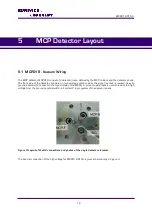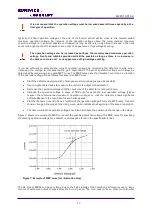
MCPD18 R104
Voltages must not be applied to the device while at atmospheric pressure. The pressure
should be 1E-6mbar or lower at the microchannel plate before applying voltage.
Otherwise, damaging ion feedback or electrical breakdown will occur.
6.4 Operation
A dry-pumped or well-trapped/diffusion-pumped operating environment is desirable. A poor vacuum
environment will most likely shorten MCP life or change MCP operating characteristics.
A pressure of 1E-6mbar or better is preferred. Higher pressure can result in high background noise
or even to damaging due to ion feedback or to an electrical breakdown.
Apply voltages as defined in chapter 4. If fluctuations appear, damage or contamination should be
suspected and the voltage should be turned off. The assembly should then be inspected before
proceeding.
Voltage across single MCPs should not exceed the maximum voltage given in P and in the
specification sheet of the detector. Higher potentials may result in irreversible damage.
MCPs can be degraded by exposure to various types of hydrocarbon materials which raise the work
function of the surface, causing gain degradation.
Operation at higher temperatures (> 50 °C) will cause gain degradation.
MCPs may degas for quite a while during operation. The pressure increase also depends on the
number of initial particles given to the MCP (e.g. pressure increase from 5E-10mbar up to 1E-8mbar
for a new chevron MCP stack). A degas procedure for MCPs is described in chapter 6.6.
6.5 MCP Lifetime and Operation Voltage
The lifetime of the MCPs is determined by the MCPs gain degradation over time, whereas the gain
degradation is a function of the extracted output charge. Therefore the lifetime of the MCPs strongly depends
on the count rate applied to the detector over time.
The typical gain degradation of a MCP is shown in Figure 5 as a function of extracted output charge in terms
of coulombs per square centimeter.
15






































